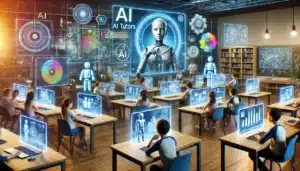As we delve into the transformative era of education, Artificial Intelligence (AI) emerges as a powerful catalyst for change. With the capability to tailor learning experiences to individual needs, AI is not just a technological advancement; it is a profound shift in how we perceive and implement education. With AI taking over in all sectors of life, whether it is AI in transportation, influencers or education, this article explores the multifaceted impacts of AI on personalized learning, the challenges it brings, and the future it promises for learners and educators alike.
How is AI Reimagining Education for Learners?
What are the benefits of personalized learning through AI?
The advantages of automated learning with the aid of AI technology are unimaginably comprehensive and life-changing. AI can be utilized to improve education systems, putting every child in a position to succeed by letting them interact with material in a way that suits their pace and preferred learning method. AI platforms have the capability to process data and determine a learner’s strengths and weaknesses, allowing for customized teaching methodology based on individual needs. The restructuring of the education system with this model adapts to all learners, no matter their academic level or socioeconomic status, providing differentiated quality education to all. Such tailored learning systems foster increased motivation to engage with the subjects and encourage every learner to endeavor to gain a profound understanding of the concepts.

How does AI tailor learning experiences for individual needs?
AI tailors learning experiences by utilizing sophisticated algorithms that analyze vast amounts of data related to student performance and engagement. For instance, by tracking a young person’s interactions with educational content, AI can identify patterns and preferences, thus customizing learning paths that align with the learner’s interests and educational goals. This deep learning process enables an adaptive learning environment where instructional content is dynamically adjusted to suit each student’s evolving needs. Furthermore, AI can facilitate blended learning by integrating various educational resources, allowing learners to engage in a mix of online and in-person interactions that enrich their educational experiences.
What role do educators play in an AI-driven learning environment?
In an AI-driven learning environment, the role of educators is redefined rather than diminished. Educators become facilitators of learning, equipped with tools and insights powered by AI to better support their students. Professional development programs are essential to prepare educators for this shift, ensuring they possess the skills to leverage AI technologies effectively. Rather than merely delivering content, teachers can focus on cultivating relationships with students, understanding their unique challenges and aspirations, and guiding them through their personalized learning journeys. This collaborative approach not only empowers learners but also transforms the teaching and learning dynamics within educational environments.
What are the Challenges in Reimagining Educational Services with AI?
What barriers do districts face in implementing AI solutions?
Barriers in Education Districts still have to overcome numerous AI-proposed solutions. AI has the potential to greatly enhance educational experiences, but the actual implementation of its benefits into classrooms faces hurdles. That gap is defined by access to technology. The infrastructural inadequacies of many districts, especially in low-income areas, restrict these institutes from easily adopting AI-powered tools. Moreover, there are stringent requirements in relation to data safety and privacy, which make it extremely difficult for schools to manage sensitive student information and data. Properly, these gaps require strong advocacy on behalf of state education agencies to ensure equal access to AI technologies, as well as transformation aid for all districts.
How can we ensure equitable access to AI-driven education?
To tackle this challenge, balanced measures AI-enhanced programs require differential treatment concerning access to affordable technology, trained personnel, subsidized related services, and robust infrastructure. AI initiatives aim to improve the discourse on additive manufacturing. AI programs enable schools to collaborate with tech companies to increase specific, equally tailored materials for students of all academic grades and skills. IT initiatives, on the other hand, can aid those students who lack the means to access them. By placing AI-powered assists into the hands of students, more dedicated shifts focus on fairness while being powered in a way that looks to give every student the tools needed to succeed, thereby shifting to be tailored to their unique challenges as well as backgrounds.
What professional development is necessary for educators?
To effectively integrate AI into classrooms, educators require robust professional development that focuses on both technological proficiency and pedagogical strategies. Training programs should emphasize how to utilize AI tools to enhance instructional practices, assess student progress, and tailor learning experiences. Additionally, ongoing professional learning opportunities are crucial for educators to stay abreast of the latest advancements in AI technologies and educational methodologies. By fostering a culture of continuous learning, we can empower educators to embrace the changes brought about by AI and to transform their teaching practices accordingly.
How Can Educators Empower Learners in an AI-Enhanced Learning Environment?
What strategies can educators employ to foster engagement?
Educators can employ a variety of strategies to foster engagement in an AI-enhanced learning environment. One effective approach is to incorporate gamification elements into the learning process, leveraging AI to create interactive and rewarding experiences that motivate students. Additionally, educators can facilitate collaborative projects that allow learners to work together, utilizing AI tools to communicate and share resources seamlessly. By encouraging student voice and choice in their learning experiences, educators can cultivate a more dynamic and engaging classroom atmosphere, where learners feel empowered to take ownership of their educational journeys.
How do teaching and learning dynamics change with AI?
The introduction of AI into educational settings fundamentally alters teaching and learning dynamics. Traditional, one-size-fits-all approaches give way to differentiated instruction that meets the needs of diverse learners. Educators become more like coaches, guiding students through personalized pathways while AI handles routine assessments and data analysis. This shift allows for more meaningful interactions between educators and learners, as teachers can devote time to building relationships and providing targeted support. Furthermore, the emphasis on student agency encourages young people to become active participants in their own learning, fostering critical thinking and problem-solving skills essential for the future.
What tools can educators use to support personalized learning?
Several innovative tools are available to educators looking to support personalized learning through AI. Learning management systems (LMS) equipped with AI capabilities can analyze student data and provide insights that inform instructional planning. Additionally, adaptive learning platforms allow students to progress at their own pace, delivering customized content based on their performance. Other resources, such as AI-driven tutoring programs and assessment tools, can provide real-time feedback and support, enabling students to address challenges as they arise. By integrating these tools into their instructional practices, educators can create a more responsive and effective learning environment.
What is the Future of Learning in a Reimagined Education Landscape?
How will AI shape learning communities in the future?
AI is poised to reshape learning communities significantly, fostering collaboration and connectivity among learners, educators, and educational institutions. As AI technologies evolve, we can expect more integrated platforms that facilitate communication and resource sharing across diverse learning environments. This interconnectedness will create global learning opportunities, allowing students to engage with peers and experts from around the world. By breaking down geographical and cultural barriers, AI can promote a more inclusive and enriched learning experience, ultimately transforming the educational landscape into a more collaborative and supportive community.
What innovations are on the horizon for educational technology?
The horizon for educational technology is bright, with numerous innovations on the verge of transforming the way we approach learning. Advances in machine learning and natural language processing are expected to lead to even more sophisticated AI tools that can analyze student behavior and adapt content in real-time. Virtual and augmented reality technologies will likely play a significant role in creating immersive learning experiences, allowing students to explore complex subjects in engaging and interactive ways. Furthermore, the development of AI-driven analytics will provide educators with deeper insights into student progress, enabling more informed decision-making and instructional adjustments.
How can we prepare learners for a future with AI?
Preparing learners for a future with AI requires a shift in educational priorities, focusing on equipping students with the skills they will need to thrive in an AI-driven world. Critical thinking, creativity, and digital literacy are essential competencies that should be woven into the curriculum across all educational levels. Additionally, fostering a growth mindset will encourage learners to embrace change and adaptability, essential traits in a rapidly evolving technological landscape. By redesigning learning experiences to emphasize these skills and promoting a culture of innovation, we can empower young people to navigate the complexities of the future confidently.
How Can We Redesign Learning Experiences to Maximize AI’s Impact?
What are best practices for integrating AI into instructional methods?
To maximize AI’s impact on education, best practices for integrating this technology into instructional methods must be established. This includes aligning AI tools with clearly defined learning objectives and ensuring that they complement existing pedagogical approaches. Educators should also engage in reflective practices to assess the effectiveness of AI implementations, making necessary adjustments based on student feedback and performance data. Collaboration among educators to share insights and strategies can further enhance the integration process, fostering a community of practice that drives continuous improvement in AI-enhanced learning.
How can educators cultivate a collaborative learning environment?
Cultivating a collaborative learning environment involves creating spaces where learners feel safe to share ideas, ask questions, and engage with one another. Educators can facilitate this by utilizing AI tools that promote group work and peer feedback, encouraging students to take an active role in each other’s learning. Implementing project-based learning strategies that require teamwork can also foster collaboration and critical thinking skills. By valuing diverse perspectives and promoting a culture of respect and support, educators can enhance the overall learning experience for all students.
What role does in-person interaction play in a digital learning world?
While AI and digital technologies are transforming education, in-person interaction remains a vital component of effective learning experiences. Face-to-face interactions foster social skills, emotional intelligence, and a sense of community among learners, which are essential for holistic development. In a blended learning model, educators can leverage the strengths of both digital and in-person experiences, creating opportunities for hands-on activities, discussions, and collaborative projects. By integrating in-person interactions with AI-driven tools, we can create a well-rounded educational experience that prepares learners for both academic success and personal growth.
Conlcusion
The development of artificial intelligence in the coming years will make it possible to design and integrate very unique and effective engagement methods into the curriculum. The use of AI-powered applications will allow students to navigate through the learning system at their pace, thus breaking traditional barriers and paradigms in education. Education will become more flexible and tailored to individual preferences.



